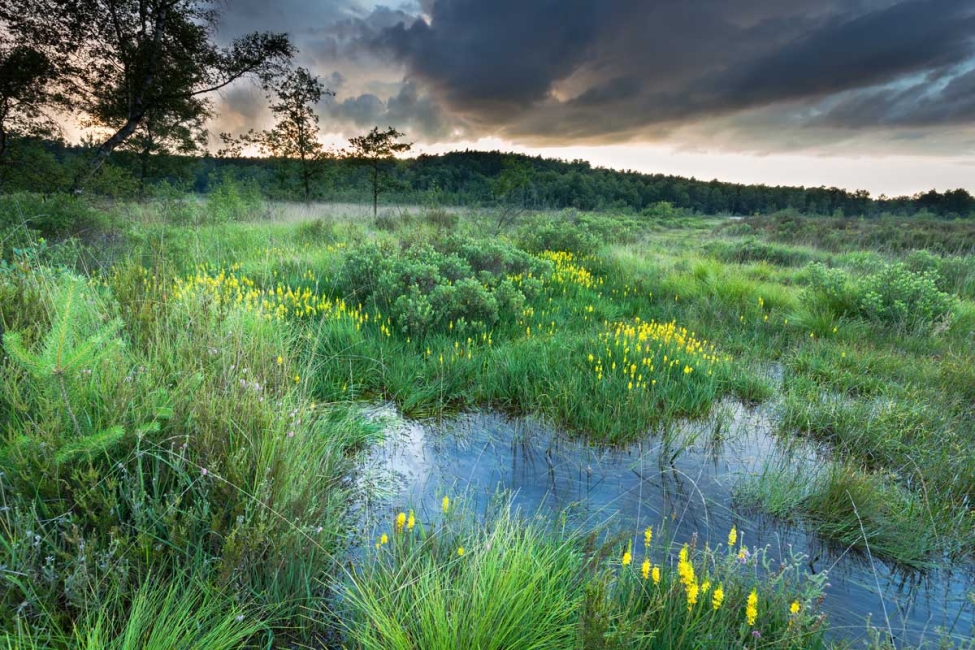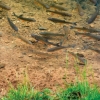
Stormwater management succeeds when the landscape itself is considered the first line of defense. Certain parts of that landscape offer outsized benefits or face outsized risks, and thoughtful planning around them is essential. Special Value Features are areas that deliver exceptional stormwater benefits by slowing, filtering, or absorbing runoff. Riparian corridors hug streambanks and provide natural flood buffers, wetlands store and cleanse large volumes of water, hydric soils soak up rainfall like sponges, and floodplains spread high flows across wide areas, reducing downstream peaks. Sensitive Features, in contrast, are locations that can suffer severe damage when runoff is altered. Steep slopes erode rapidly under concentrated flows, while adjacent properties can flood or destabilize when drainage patterns shift.
Ignoring either category has compounding effects. Filling a wetland or channelizing a riparian zone eliminates storage and filtration capacity, which increases the volume and velocity of runoff. That faster water then scours steep slopes, carries more sediment, and overwhelms pipes before spilling onto neighboring parcels. The result is a chain reaction of higher flood peaks, degraded water quality, and mounting public and private costs.
Successful protection begins at the earliest stages of project conception. Before layout sketches appear, a site inventory should map all streams, wetlands, floodplain boundaries, hydric soil polygons, and slope classes. Once delineated, these areas guide the placement of roads, buildings, and utilities. Clustering development on upland or previously disturbed portions of a parcel preserves contiguous riparian or wetland buffers and reduces infrastructure footprints. Where disturbance near a Special Value Feature is unavoidable, maintaining or restoring a vegetated buffer of native grasses, shrubs, and trees intercepts sediment and nutrients long before they reach the feature itself.
Construction phase controls must then match the sensitivity of the surrounding land. Silt fences or compost filter socks are standard, yet near hydric soils or steep slopes they should be paired with temporary diversions that route clean upland water away from exposed soils. Scheduling earthwork during drier months minimizes saturation‐driven rutting, and rapid stabilization with mulch and seed locks soil in place. Equipment corridors should stay out of defined buffers and be reinforced with geotextile and stone if repeated passes are necessary.
Post-construction, design elements that work with the land help ensure lasting protection. Forebays, bioretention cells, and level spreaders positioned upslope of wetlands or riparian areas temper inflow energy and trap pollutants. Where development presses against a floodplain edge, elevating structures on piers and preserving overbank conveyance space keeps water in its natural corridor, sparing adjacent properties from backup. On steep terrain, terraced retaining walls paired with infiltrating planter strips reduce slope length and promote infiltration.
Maintenance closes the loop. Even a perfectly designed buffer degrades if invasive species displace deep-rooted natives or if accumulated debris blocks overflow paths. Annual inspections should check for eroding outlet aprons, undermined silt fences left in place, and sediment buildup in forebays. Corrective actions—regrading rills, removing invasives, or dredging accumulated sediment—are most effective when performed promptly, before damage propagates downslope.
Regulations reinforce these best practices, but they rarely stand alone. Federal wetland protections under Section 404 of the Clean Water Act mandate permits for fills, while many states overlay stricter buffer or stormwater volume requirements. Local ordinances may impose additional setbacks from steep slopes or cumulative runoff caps for redevelopment. Integrating these layers early prevents redesign surprises and streamlines approvals.
Protecting Special Value and Sensitive Features is not merely an environmental add-on. It is a cost-effective strategy for meeting stormwater volume, rate, and quality objectives simultaneously. By identifying these areas, respecting their natural functions, and weaving them into site design and long-term stewardship, developers safeguard public infrastructure, neighboring properties, and the ecological assets that keep watersheds resilient.
 Wetlands are often described as the kidneys of the watershed because they filter, slow, and transform the water that passes through them in ways that …
Wetlands are often described as the kidneys of the watershed because they filter, slow, and transform the water that passes through them in ways that …
 Field inspections of catch basins, manholes, culverts, and outfalls form the foundation of responsible stormwater management. These routine checks giv…
Field inspections of catch basins, manholes, culverts, and outfalls form the foundation of responsible stormwater management. These routine checks giv…
 Habitat disruption around drainage structures is often subtle at first, and many of the earliest signs tend to appear during ordinary field work rathe…
Habitat disruption around drainage structures is often subtle at first, and many of the earliest signs tend to appear during ordinary field work rathe…
 Harmful algal blooms have become one of the most pressing water quality problems in many regions, and their rise has been linked to a complicated blen…
Harmful algal blooms have become one of the most pressing water quality problems in many regions, and their rise has been linked to a complicated blen…
 The Salton Sea is one of California’s most unusual and tragic landscapes, a place shaped by accident, transformed by ambition, and ultimately pu…
The Salton Sea is one of California’s most unusual and tragic landscapes, a place shaped by accident, transformed by ambition, and ultimately pu…
 *The screenshots used in this article are from Roadwurx, an asset management software created for road maintenance departments. Managing a town’…
*The screenshots used in this article are from Roadwurx, an asset management software created for road maintenance departments. Managing a town’…